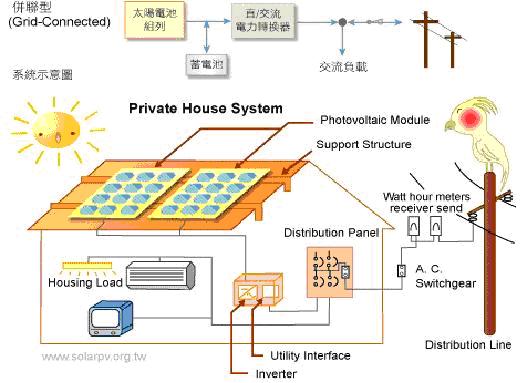SMILE SOLAR ENERGY CO., LTD.
請注意:您正前往的網頁需要授權才能進入。
【Knowledge】Q1 What are the differences between solar PV system and solar water heater?
The use of solar energy can be classified as solar thermal and solar PV. The solar PV cells are to transfer the light into power, while the solar water heater is to absorb solar thermal to heat water.
【Knowledge】Q2 Will the module with higher conversion efficiency generate higher power generation under the same capacity?
Under the standard testing condition, the module’s conversion efficiency is the electricity output and sunshine power input (sunshine intensity times module area). It represents the module’s output power per unit area. Under the same system capacity, the module’s conversion efficiency doesn’t have the direct relationship with the system’s electricity generation capacity. The module will need less setting area using higher conversion efficiency.
【Knowledge】Q3 How much KWh can the solar PV system generates per year?
Because of different sunshine conditions of Northern, Central, and Southern Taiwan, the power generation of each area is different. The following table is the average power generated by solar PV system that is subsidized by Bureau of Energy,Ministry of Economic Affairsof each city in 2011:.JPG)
.JPG)
【Knowledge】Q4 What is grid-connected solar PV system?
Operating in parallel with the power system and conveying power to power system, this kind of solar PV system is collectively called grid-connected solar PV system (equipment). The connection of grid-connected system can be located in the inside of private house or outside of Taiwan Power Company, depending on the setter’s requirement of power application and wholesale electricity. The following figure is solar PV system output connected to the outside. (The generation power is all for wholesale):

【Knowledge】Q5 How long is the life time of solar PV system?
The solar PV system contains of module, DC junction box (containing isolation switch and protection components), inverter, AC distribution board (containing DC switch and protection components), and other important components, and through piping and wiring installation. Modules and inverters are two critical system components. Its quality, reliability or life time is related to power generation system’s performance and life time. The solar PV system should adopt qualified modules and inverters to make sure the quality. The current verifying norms of modules are IEC, UL, CNS, and other norms, while the current verifying norms of inverters are VDE, EN, IEEE, CNS (partial), and other norms. Under normal using conditions, the life span of module passing verifying norms is about 20 years (Guarantee for greater than or equal to 90%rated output power in 10 years; greater than or equal to 80%rated output power in 20 years produced from solar panel factory), and that of inverter passing verifying norms is about 10 years.
【Knowledge】Q6 Will the solar PV system make noise or EM wave?
When the solar PV system is operating, it won’t make noise. The main electrical components of the system are modules and inverters. Because the module output is DC, it won’t cause high-frequency radiation. The function of inverters is to transform DC into AC. The inverters should accord to International EM interference and related compatible specifications before being official listed (Such as EN61000-6-2 and EN31000-6-3), so there should be no harmful concern of EM wave to human.
【Knowledge】Q7 What are the international current commonly used safety specifications of related components for solar PV system?
To ensure the quality and conversion efficiency of PV module, the following are commonly used international certification standards:
Crystal silicon:IEC61215、JIS C8990、CEC503
Non crystal/ membrane module:IEC61614、JIS C8991、CEC701
There are other safety norms for BIPV (such as UL1703) to make sure that PV module passes fireproof, air pressure, anti-aging, and other tests to confirm it can be used outside for a the long time. In addition, the following are the certification institutions and standards for DC/AC inverters:
Crystal silicon:IEC61215、JIS C8990、CEC503
Non crystal/ membrane module:IEC61614、JIS C8991、CEC701
There are other safety norms for BIPV (such as UL1703) to make sure that PV module passes fireproof, air pressure, anti-aging, and other tests to confirm it can be used outside for a the long time. In addition, the following are the certification institutions and standards for DC/AC inverters:
| Country | Certification institution/Lab | Certification standard |
| Germany | VDE Testing and Certification Institute | VDE 0126 / VDE 0126-1-1 |
| America | Underwriters Laboratories Inc. | UL 1741 |
| Japan | JapanElectrical Safety & Environment Technology Laboratories(JET) | Test method for Solar PV system |
【Knowledge】Q8 What can the use of solar power help us?
The use of solar power is completely free. With power generation equipment, the electricity is free! The price of solar PV cells was high in the early time. When the solar PV cells were generating electricity for consumer products, it was inconsistent with the economic benefit. The commonly use included apace station, satellite generation, and other SCADA generation systems on mountains, islands and ocean, or solar watch, solar calculation and so on. In the recent years, price of solar power generation equipment has greatly reduced, and its application range becomes wider and wider. Public work on electricity like street lights, signs; casual electricity like RV’s, boats, solar vehicles; personal electricity like house use are becoming feasible.
【Knowledge】Q9 How to decide the power generation of solar panels ?
It is according to ASTM (American Society of Test and Material) E892 testing standards, the output of solar panels under 1000W/m² and 25℃in the lab. Thus, the higher the power is, the bigger the solar panels are. Generally, now all brands of commercially available solar panels’ generation efficiency has no great differences. As far as the crystalline silicon PV panels are concerned, if the power generation capacity is about 110W/m², then setting 1kw solar power system needs approximately 9m² (100.8 square feet).
【Knowledge】Q10 How to maintain the solar panels?
The solar panels barely need to maintain. Only need to keep the surface of solar panels which is facing the sun clean.
| PREV | 0102030405 | NEXT |











